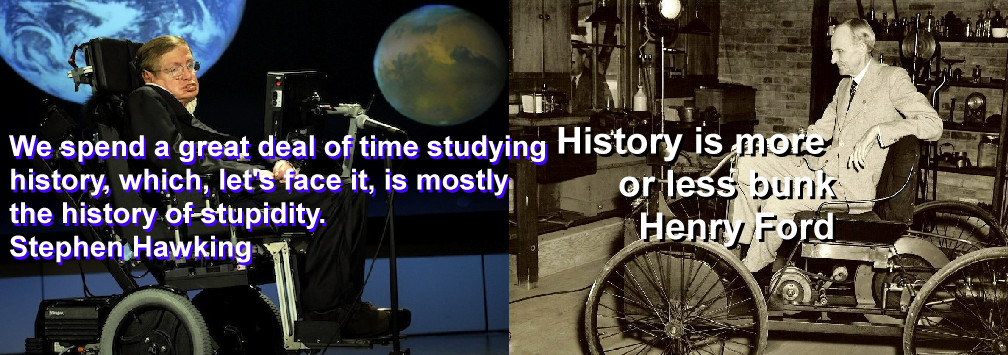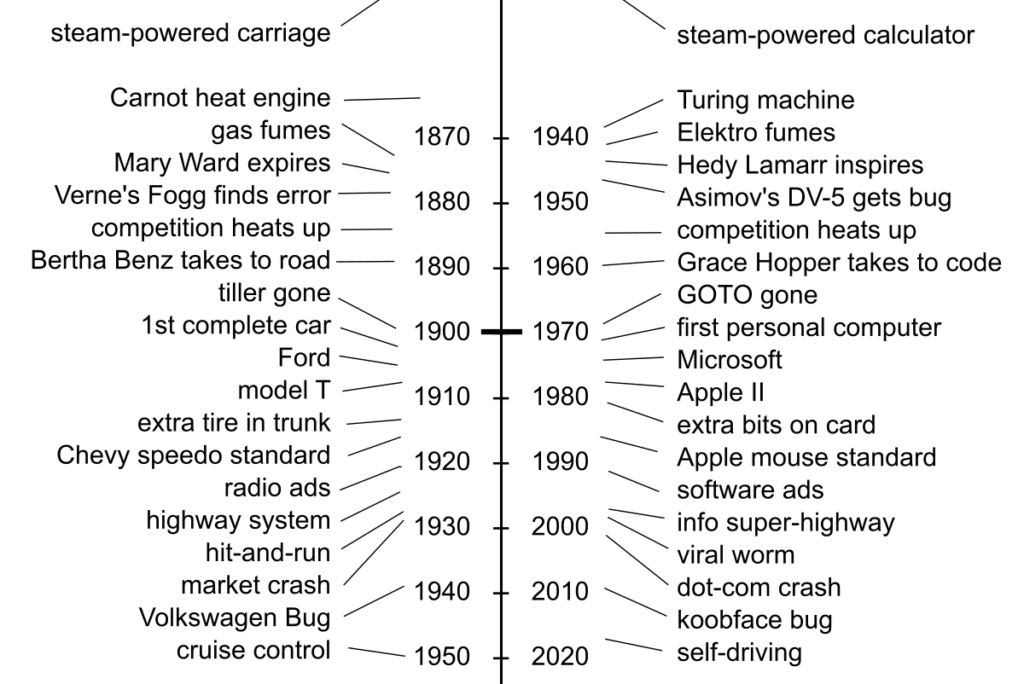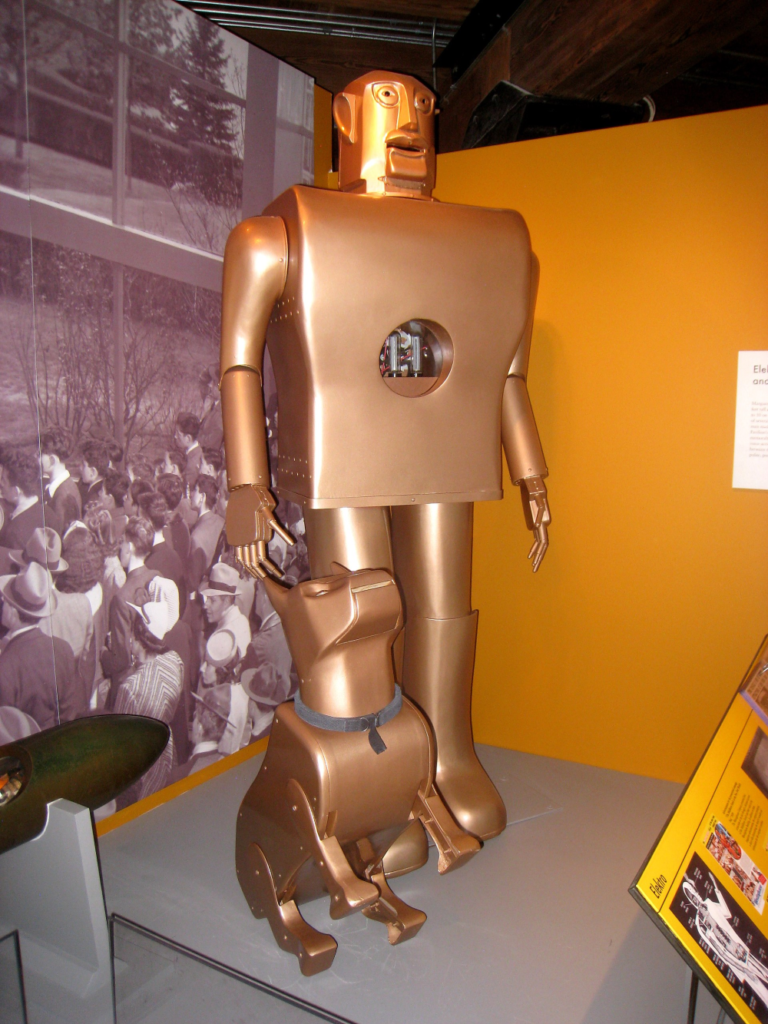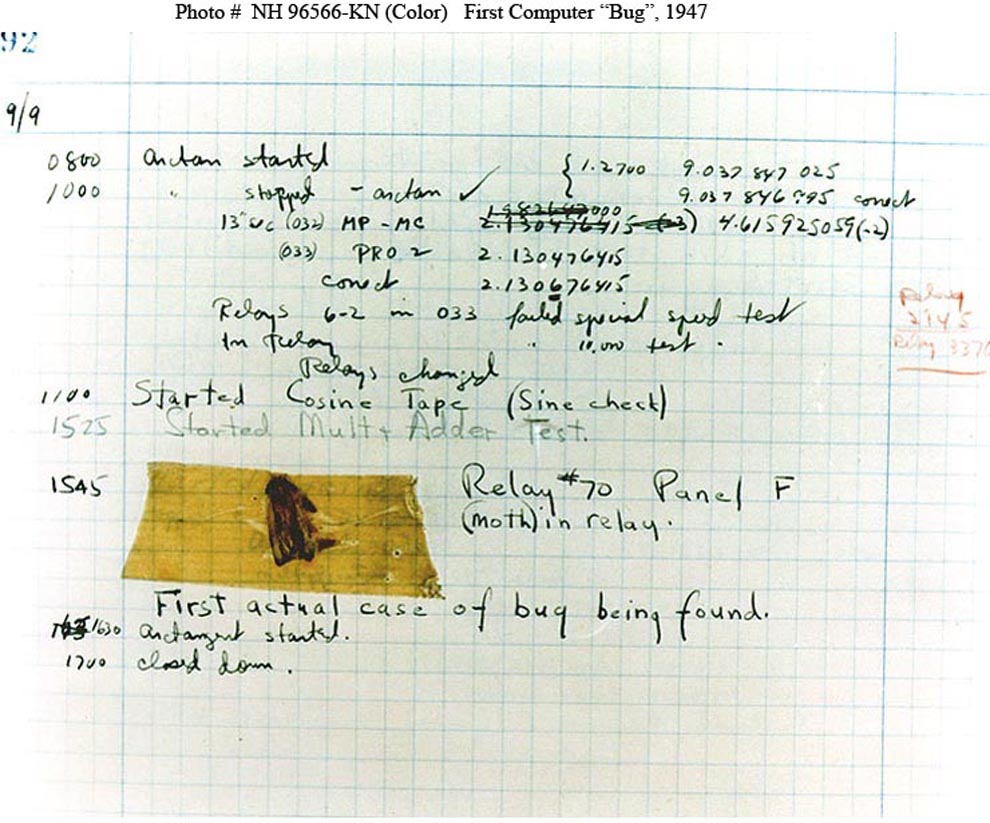
Computer programmers who deal with dates and times will probably recognize the date January 1, 1970. Although no one knew it then, this day is now widely accepted as a standard starting point for computer clocks, and it serves as a rough start time of the Information Age.
The turn of the century, January 1, 1900 serves as a similar starting point for the Automobile Age. If it is true that history repeats itself, then the history of the horseless carriage might give a sense of where we are in the history of computing.
Certainly there were significant events in both time-lines before these somewhat arbitrary starting points. In the year 141 BCE. (Before the Computer Epoch), Charles Babbage had drawn up plans for a steam-powered calculator. Among other tasks, Babbage hoped to calculate better tables for aiming cannons, but funding ran out around 131 BCE. In the other time scale, 131 BCC (Before the Car Century) was more successful for Nicolas Cugnot, who completed a working model of his steam-powered vehicle for transporting cannons.

Theoretical foundations had been laid down by the father of thermodynamics Nicolas Carnot, whose work was largely unknown and almost lost during his short lifetime of 36 years, but he had determined the limits of mechanical efficiency with his theoretical “Carnot Heat Engine”. Similarly, the father of computer science Alan Turing died young at age 42 after determining the limits of computation with his theoretical “Turing Machine”. Turing’s work was largely unknown due to the top secret nature of many of his accomplishments.

Around 30 BCE/BCC, the future of air quality suffered a hit with the invention of the first gasoline powered vehicle, and “Elektro” the cigarette smoking robot. Writers started to notice the potential of both technologies, and speculated about possible lessons from the related fields of railroads and robots. In 27 BCC, Jules Verne wrote, in “Around the World in 80 Days”, about Phileas Fogg discovering an error in a railroad timetable while Detective Fix is trying to catch up and arrest him. In 26 BCE Isaac Asimov wrote about a “bug” in a robot, and a search for a fix in the short story “Catch That Rabbit”.
Competition was on the rise in 22 BCE, with the first city-to-city automobile race to promote the technology, and in 22 BCC with increased competition between commercial computer designs after the secrecy of World War II.

In both timelines, women were leaders. Unfortunately for the artistically gifted engineer Mary Ward, she is more often remembered for being the first person killed by an automobile, in 31 BCC. Hedy Lamarr is often remembered for her artistic achievements in film, but also as an inventor, including improvements to traffic stoplights. In 28 BCE she was co-inventor of spread spectrum and frequency hopping technologies. In 18 BCE, Grace Hopper invented the first compiled computer language to promote speedier programming, while in 12 BCC, Bertha Benz sped 80 km to became the first long-distance driver, in a promotion of her family’s business.
In 9 BCC, two people were harmed in the first gas powered automobile accident, while in 9 BCE two players first attempted to harm each others’ space craft in the computer game SpaceWar! The potential for things to go wrong gained attention in 2 BCE when Edsger Dijkstra wrote “GOTO considered harmful”, leading to strong opinions among programmers being considered harmful, but the GOTO statement eventually lost to the FOR loop. In 2 BCC, the debate was between the steering tiller and the steering wheel, with the tiller going, going, gone where the GOTO was going to go.
Shortly after the starting points of both timelines, commercialization really began. In 1 ACC, Maybach and Daimler produced the Mercedes 35 HP, which is widely considered to be the first complete automobile, and sold 36 before moving on to design other commercially successful cars. In 1 ACE, John Blankenbaker produced and sold 40 Kenback-1 computers, considered the first personal computer, before moving on to bankruptcy.
Things really got going in 5 ACC/ACE with the founding of the Ford Motor Company, and the founding of Microsoft. In the same years, the American Automobile Association began publishing road maps for early driving enthusiasts, while Dr. Dobbs Journal began publishing directions for early programming enthusiasts. In 6 ACE, Wozniak and Jobs started selling the Apple I for $666.66, with the price dropping over time. In 8 ACC, Henry Ford started selling the Model T for $825.00, with the price dropping over time.
In 9 ACC, Rambler realized that four tires just weren’t enough, and invented the spare tire to keep customers moving with little fuss. In 9 ACE, Microsoft realized that 8 bits just weren’t enough, and invented the “soft card” to keep customers moving to 16-bit processors with little fuss.
But neither Henry Ford nor Bill Gates could relax. In 14 ACC, Chevrolet made the speedometer standard in its products, and began an aggressive campaign to compete directly in a market dominated by the Model T. In 14 ACE, Apple made the mouse standard in its products, and launched the Macintosh with an aggressive Super Bowl ad to compete in a market dominated by the PC.
By this time, lawmakers started to take the technologies seriously. Al Gore wrote legislation to promote traffic on the “Information Super-Highway” and the World-Wide-Web was launched to the public. On the automotive time-line, the public was taking to newly organized physical highways, and police invented the upraised-hand stop signal, the no left turn sign, and networked traffic lights to control and ease traffic problems. In sensational news of the time, five children were injured by a car whose driver failed to stop afterwards. On the computer timeline, Robert Morris created a test worm which infected the Internet by accident because it failed to stop after the test.
In 22 ACC, WEAF radio in New York began the new idea of selling broadcast time to advertisers, with Tidewater Oil being an early client from the automotive industry. In 23 ACE, SBC Software Broadcasting launched, leading to the world’s first listing in the Yellow Pages’ new category “Advertising – Computer”.

In 29 ACC, the stock market crashed and took the automotive industry with it. In 31 ACE, the dot-com bust did the same thing to the computer industry. But on the plus side, the Apple iPod was the best thing for music lovers on-the-go since 33 ACC, when Motorola car radios hit the mass market.
In 35 ACC, a flashing light was invented so everyone knew which way a car was turning without a driver’s hand signal. In 35 ACE, Stanford won a competition for a car which knew which way to turn without a driver.
In 38 ACC, the Volkswagon “Bug” entered the marketplace. With the help of creative advertising campaigns targeting social trendsetters who would spread the word to their friends, the Bug went on to sell over 15 million vehicles over the years. In 38 ACE, the koobface worm targeted social media sites facebook and myspace by using Friends lists to spread, eventually infecting at least 5 million computers over the years.

In 45 ACC, Ralph Teetor invented cruise control. In 45 ACE, serial liar Elon Musk announced that Tesla had solved all major problems with self-driving cars, with the exception of legal concerns.
So what does the year 2018 (48 ACE) hold? Well, if history repeats then get ready for windows that go up and down with the flick of a switch, but somehow, I don’t think that will really catch on. I think the coming air conditioning app will be very popular, but maybe fins and more chrome will be easier to manufacture. In any case, I am hoping I don’t have to wait 10 years for seatbelts, if they can lessen the impact of a crash.
return TRUE;